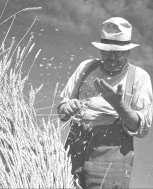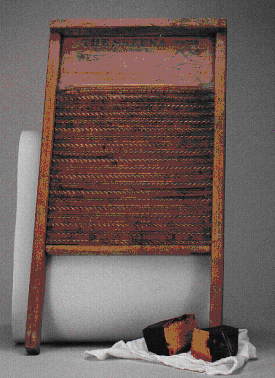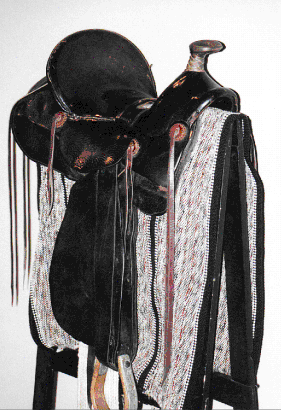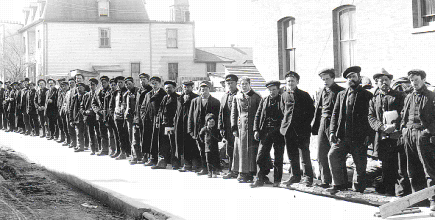
For most prairie communities farming was the main reason for settlement. In Lethbridge it was coal mining that brought the first settlers to the area. It was not until the coal mines closed that farming became Lethbridge's biggest business.

P19754409177-GP A farmer study's the result of his hard work, a bumper crop of grain.
The rich soils of the Lethbridge area were created in the distant past by several ice ages in which giant glaciers moved across the Prairies and then melted. They left behind volcanic ash and dirt, which mixed with the loess soils (soils which are yellow-brown in colour) which were left by wind and water. These events created Lethbridge's dark brown soil. The plants that naturally grow in this soil are called "mixed-grass;" they are called this because all the grasses are tall or medium in height.

P19738578333-GA Washboard and Soap, This was the washing machine of the pioneers.
Each year Lethbridge gets about 405 millimetres of rain, and there are about 100 to120 days that are warm enough to grow crops. If this was all that mattered, Lethbridge would be a very good place to be a farmer. But, the amount of rain that comes each year is not dependable. Some years are very wet and others are very dry. Also, southern Alberta has very strong winds that are hot and dry. These winds cause a lot of the water to evaporate and they dry out crops.
Lethbridge has is well-known as Alberta’s “windy city.” Lethbridge is known for a special type of wind. These winds are called "Chinooks", and they are very warm and dry. Chinooks are created when warm air from the Pacific Ocean is pushed over the Rocky Mountains. As the air rises, it cools and releases the moisture it has built up. The moisture falls in the mountains as rain. Then as the air goes down on the east side of the mountains it becomes warm. So, when this air reaches Lethbridge it is as a very warm and dry wind. Historically the Chinook has been both a blessing and a curse. Some people like the Chinook winds and some people don't. Ranchers, who raise cattle and other animals, like the Chinook because it keeps their animals warm in the winter. Also, the Chinook melts snow, which makes it easier for animals to find food on the ground. But farmers don't always like the Chinook. Chinooks evaporate water from the ground and crops need this water to live. As well, Chinooks dry up and then blow away the topsoil on fields. Topsoil is full of food for plants and is very important, so when topsoil is blown away farmers cannot grow crops there any more.
 P19662330000-GA
Calf Weaning Helmet. (Clickable)
P19662330000-GA
Calf Weaning Helmet. (Clickable)
At first, people who came to Lethbridge thought that it was a desert and could not be used for farming. These people thought that Lethbridge was only good for raising cattle, so they began ranching. But soon they found out that the Texas Longhorn cattle, that were used in the United States, were not used to how cold Lethbridge was and could not survive the long southern Alberta winter. To fix this problem ranchers tried using a different breed of cattle. Ranchers brought a new breed called the Hereford to southern Alberta from Britain.
 P19760205040-GA Herd of Hereford Cows. (Clickable)
P19760205040-GA Herd of Hereford Cows. (Clickable)
The Hereford had a thick coat and was used to cold weather so it did well in southern Alberta. The Hereford was so popular that it is still used by ranchers in southern Alberta today. The invention of the refrigerated rail car in 1875, and the coming of the CPR in 1883, also helped southern Alberta ranches by making cattle transportation cheaper and safer. Southern Alberta ranchers did very well until the winter of 1906, when large amounts of snow and cold temperatures caused tens of thousands of cattle to starve to death. Because of this disaster, many of the ranch lands in southern Alberta were empty. But these empty lands were soon filled by farmers who only wanted to grow crops.

P199738228000-GA Western Saddle.
Before farming began in southern Alberta, the government sent men to study the land and see if it was any good for farming. In 1858 Captain John Palliser, who was working for the British Government, studied the Canadian plains from southern Manitoba to southwestern Alberta. He studied the area during a time when there were many dry years in a row and said that most of the region was not good for settlement. The area Palliser studied is now known as "Palliser's Triangle."
In 1870 the Hudson's Bay company sold the Prairie regions to the newly formed country of Canada. At this time, the Canadian Government hired a scientist named John Macoun to study the Palliser's Triangle region to find out if it was good for farming. Macoun thought that if farmers would turn up the soil there would be more rain, and because of this, he said that southern Alberta would be good farmland. Macoun's findings were then used by the CPR to persuade the Canadian Government to open the prairie regions for settlement. In 1905 the Canadian Government gave in to pressure from prairie residents and the CPR and decided to open the Canadian Prairies for farming.

P19800016005-GP Japanese farm laborers take time to pose for a picture
Settlement of the Lethbridge region by farmers brought people of many different ethnic and religious backgrounds to the area. One of the first groups to settle the Lethbridge area for the purpose of farming was a group from the Church of Jesus Christ of Latter-Day Saints, who are also known as the Mormons. The Mormons had farmed the very dry lands in the state of Utah by using irrigation to water crops. Some of the Mormons wanted to leave Utah because there was very little good land left. Also the government of the United States mistreated some Mormons because they were polygamists. Polygamists are people who have more than one wife and many Americans were against this practice. At the same time, the Galt family had decided to use irrigation on their land in southern Alberta. In 1887,Charles Ora Card and 41 other Mormons were invited by the Galts to settle in the area of Lee's Creek, near what is today Cardston. The Galts told the Mormons that they would give them money and land if the Mormons would build an irrigation system for them. The Mormons accepted this offer and went on to build the St. Mary's Irrigation system.

P19730037000-GP Ora Card's homestead near Lee's Creek in what is today Cardston.
In 1905 Alberta became a province of Canada and southern Alberta began to fill up with farmers who were eager to work the newly-irrigated land. On one day in September of 1908, more than 1000 people assembled at the Lethbridge land office to buy farmland in the area. The land rush peaked in 1910 when almost 5000 land grants were issued.

P19640023001-GP People lined up at the Land Office waiting to receive homesteads.
The first farmers who settled in southern Alberta found many problems waiting for them. For example in 1918 and 1919 a very bad drought hit southern Alberta. A drought is a time when there is very little rain. The drought of 1918 and 1919 showed southern Alberta farmers the dangers of soil drifting, which happened when dry topsoil was swept from the fields by strong winds. In addition to soil drifting, insects created a problem during the drought. Grasshoppers came in great numbers and could destroy an entire field. There was another big drought between 1931 and 1937. These years were known to many as the Great Depression, but were known on the prairies as the "Dust Bowl" or the "Dirty Thirties.” The drought of 1918-19 was very serious to Lethbridge area farmers. Some farmers were moved by the Canadian Government and the CPR to locations as far away as the Peace River country in northern Alberta. But, because of irrigation the drought of 1931-37 was not so bad for Lethbridge area farmers.
Previous Page | Exhibit Contents | Home | Navigation Information | Glossary | Curriculum Guide | Next Page
Copyright © 1996 Sir Alexander Galt Museum. All rights reserved.